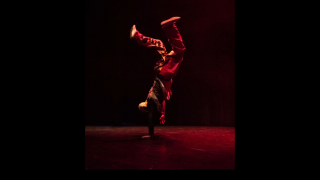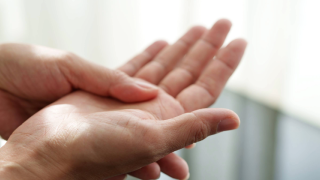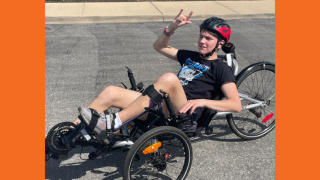Shirley Ryan Abilitylab was formerly known as Rehabilitation Institute of Chicago [RIC] during the time author Chris Jasch wrote this essay. Chris passed away in 2015. We mourn her passing and share this entry with gratitude for her insights.
Body
My name is Chris Jasch and I am an Occupational Therapist in the Technology Center at RIC. I started my career here at RIC in 1987. I worked on the stroke floor for a year then moved to spinal cord. I spent nine years with the team, five years of them as the supervisor of the OTs. In 1996, I moved to the Technology Center, formerly the Brown Center, where I’ve been working with RIC staff and your patients ever since. In 2010, I was diagnosed with ALS.
For me, the profession of Occupational Therapy was a perfect match. I thrived on having a role in a person’s return to a meaningful life. I have enjoyed the creativity and collaborative problem solving as we work with our patients to find solutions. We have all worked with patients who have overcome their disabilities to continue on with their lives, as well as with others who have not been able to see their worth after their disability. As OTs, we are in the position to help patients reach their maximum functional level, to influence their attitude, and help them see what they can do more than what they can’t do.
Disability has always been a presence in my life. My father had ALS. Having him in a wheelchair and needing assistance was just the way it was. He was my example of a person who lived his life to the best of his abilities, rarely letting his limitations get in the way of what he wanted to do with his family. For example, we continued to go to restaurants, and movies which today doesn’t sound like much of an effort. In the early 1970s, people in wheelchairs were not seen in public much. Ramps were a thing of the future. I distinctively remember him being stared at often. My retaliation was to get in their line of sight and stare right back. In 1975, during my father’s last summer and in a time without any of the technology we have now, he insisted on keeping our tradition of a summer camping trip with friends. I remember that trip fondly, my mother remembers it as a huge effort that could not have happened without friends.
When I was ten, my aunt, his sister, was diagnosed with ALS. It was then that we discovered that the familial type of ALS ran in our family. She struggled with depression and rarely left the house. My cousin, her son, passed away in 2003 of ALS. I’ve lived with the knowledge that someday myself, my sister, or my brother might be faced with the same fate.
My life is interwoven with disability. I chose a career where I worked with disability every day. I married a man with spinal muscular atrophy who lived his life in a power wheelchair. Disability, for me, has been the norm. We lived what we saw as a normal life. Ken went to college, got a full-time job, a wife, a child and a mortgage; those average expectations needed to fulfill the American dream. When we were younger, we tried not to let his disability limit us. Certainly there was planning (this was pre- ADA), and accommodations were made but we did what we wanted to do. While looking back, I think we should have opened ourselves up to getting more help. On the other hand, our struggles to find the balance between raising our daughter, working full-time jobs, taking care of his needs, and keeping up with our household responsibilities, forced us to work together to find solutions.
In November 2008 I started having fasciculations at my left knee. I was terrified. But after checking with my doctors and hoping it was a side effect of medication, I resolved to put it out of my head. In July 2009 weakness in my left foot started and panic set in. After testing we were told by a neurologist that it was not ALS. I had a bulged disk at level L4-L5 on the left side. A little physical therapy to strengthen my core should do the trick. I never truly believed these findings and feared for the worse. My wonderful coworkers became a source of great comfort when crying in my office became a regular occurrence. I was terrified of what the future held and worried about the impact this would have on my daughter, my husband and my job.
In November 2009, my husband of 23 years passed away unexpectedly. The progression of my weakness then sped up. We will never know if this was due to the natural progression of the disease or from stress. By February 2010, I needed a cane, by April I needed a foot orthosis, by June I needed a walker, and by August a scooter for distances. July 2010 brought the official diagnosis, something I already knew.
Each new stage brought a new challenge. Moving from the cane to the walker; the walker to the chair. My ability to perform those all-important ADLs progressed from independent, independent with equipment, then to the predictable MIN assist, to MOD assist, to directing my own care. I repeated those steps for every activity of daily living; bathing, dressing, toileting, feeding, driving, reaching, grasping and holding objects, typing, writing etc. I was the FIM scale in reverse. After years of rating my patients and developing goals for them to move up the scale, I was quickly moving down the scale. I watched my patients get better as I got worse.
I referred to these times as transitions. Each transition brought denial, anxiety, anger, sadness and a great fear of the future. The denial was the most dangerous. Certainly I could still (fill in the blank)… walk to the parking lot (fell), turn off the kitchen light (leaned out of my center of gravity, fell), transfer to the shower chair (fell), continue to dress myself (became a two hour task). It was as if I had never heard the words “injury prevention” or “energy conservation.”
It was pointed out to me that while I viewed each change as a transition, the reality was each stage was a loss in my life. Once I began looking at a transition as the loss that it truly was, I was able to acknowledge and grieve the loss and move to the next phase of functional change with easier acceptance and less denial.
However, the emotional toll was huge. I was blessed to have a ramp into my home, an accessible bathroom and accessible van. I used a Hoyer lift with my husband every day for twenty-three years. However these necessities were for my husband, not for me. I wasn’t supposed to need them. Yet here I was. I also struggled at work. I tried to minimize my condition. Not easy to do when I was seen using the cane, then the walker, then the wheelchair in the infamous elevators. A packed elevator is not the most ideal location to tell somebody you have worked with for 20 years that you have ALS. In a building full of medical professionals the diagnosis has an instant recognition. On a day-to-day basis as I ran into people I hadn’t seen in a while I watched a common reaction pass-through their eyes; shock, disbelief, followed by a realization of the implications, all within a 90-second elevator ride. The most common question I got was, “Are you sure?”
I was lucky enough to have coffee with Dr. Henry Betts one day. He was coming to RIC for therapy on a regular basis. We had the chance to share the irony of our situations and he told me two things that I will never forget. Dr. Betts was comfortable coming to the Institute in his wheelchair and going through therapy. But, I was reluctant to get outpatient therapy. I felt I would be taking therapy time away from somebody who really needed it. After all, I was a therapist myself and should know what needed to be done. Dr. Betts contradicted my reluctance very clearly: why would I not come to the best place in the world for therapy? Dr. Betts was wisely able to put himself in the patient role while I saw myself as an employee that was being a nuisance to other therapists.
As I expressed my fears of the future, he very gently said, “You can’t worry about what has not yet happened; the future never works out the way you think it will. You can think about what your evening will be like tonight but it won’t turn out that way. The same concept applies about tomorrow, next month, and next year.”
Along the way, I was able to use my OT skills to identify creative adaptations such as using salad tongs to reach various items because the reacher was too long, and using a pair of pliers in the car to retrieve the ATM card or a parking ticket. I started wearing skirts almost exclusively, which made toileting and dressing myself easier. I used common tricks of the trade- long shoehorn, bed ladder, leg lifters, sliding board, quad grip on my electric toothbrush, long straws, drink holder, and modified buttons on my cell phone. I even tried a balanced forearm orthosis (BFO). Work simplification and energy conservation became daily habits.
I am certainly blessed to have firsthand knowledge of available technology. I knew which options were available in wheelchairs and have easy access to the experts. I knew how to adapt my cell phone when I was still able to manipulate it and which technology to get once I lost use of my hands. I knew which electronic aids to daily living (EADL) would be the most economical and functional. Fortunately I did not have a learning curve which many of our clients have to overcome. I had been teaching voice recognition technology for the last 17 years, I now use it daily. I can think back to how many times I presented technology options that were technically possible but functionally ridiculous. I now have a user’s understanding of the inherent frustrations that come with technology. Again I am lucky that I am skilled with problem solving but have a better understanding of why some technology winds up in the closet.
And here I am today. I can fully move my head and shrug my shoulders. I can still swallow and I can still talk. More importantly, I can still laugh and cry. I can still feel joy as well as sorrow. I can feel a person’s touch, see my daughter smile, hear my cat purr, smell freshly ground coffee and taste rich dark chocolate. I am able to see that I have more blessings in my life than losses. That may sound strange coming from somebody who has experienced a tremendous number of losses in the last 4 years, but I’ve been able to see and experience an unbelievable amount of support, love, and compassion. Had I not been tested, I don’t know if I would have witnessed them as vividly. I have experienced firsthand the power of prayer-how else could I’ve survived the last 4 years? I am not angry at God but know that He is at my side helping me through this part of my life.
I still am working, seeing a few patients two days a week with the help of coworkers, students, and volunteers. My manager all the way up to RIC CEO Dr. Joanne Smith has been flexible, accommodating, and supportive beyond imagination. I’ve had several non-RIC people ask me why I’m still working, I’m certainly eligible for disability. To me the answer is simple. This is what I do, this is who I am. It is a huge part of my identity and I feel I can still contribute. My coworkers are like my family. It would be difficult not to see them on a regular basis. I’m teaching patients, students, volunteers, and maybe a few employees what perseverance looks like. I have knowledge and skills that can benefit my patients and colleagues. Plus, with Oprah off the air, daytime television is truly horrific.
Before I had my 24-hour caregiver I was at home alone for about six hours, a few days a week. Twenty-five current and former RIC OTs took turns coming over to help me with lunch and odds and ends around the house. I have people making meals for my daughter and me on a weekly basis. I still have people coming over for lunch five or six times a month. You know how we always say “let’s get together”? Well I get to do that. To spend time with people I would otherwise not taken the time to do has enriched my life. I am blessed with an overwhelming amount of support and caring from the RIC community.
Throughout this experience I have seen the RIC core values in action. I have hope that the future will be okay, however it plays out. That doesn’t mean it’s going to be easy or without sorrow, but it’s going to be okay. We’ll get through it and we won’t be alone. I have discovered a strength within myself I never knew I had. I have also discovered how wonderful the people of this world are to others. I have experienced compassion beyond measure and have been able to collaborate with the best rehab professionals in the world. In a very unexpected way, by accepting my need to be helped, I have learned perhaps more about life and love than when I worked to the best of my ability to be helpful.
Body
This content is for informational purposes only and may not be comprehensive. Information contained does not imply an endorsement from Shirley Ryan AbilityLab, and does not replace the advice of a qualified healthcare professional. See here for further details.© Shirley Ryan AbilityLab (formerly Rehabilitation Institute of Chicago). Henry B. Betts LIFE Center – (312) 238-5433 – https://www.sralab.org/lifecenter



